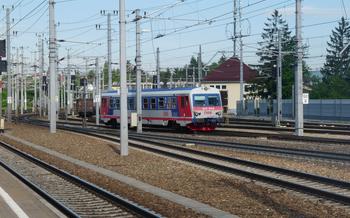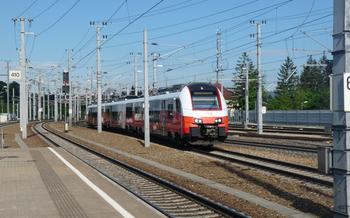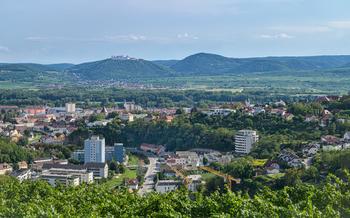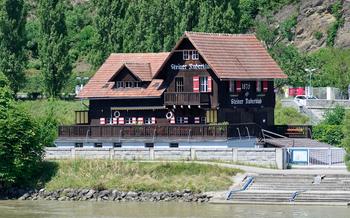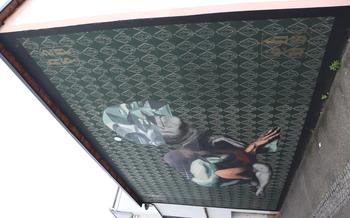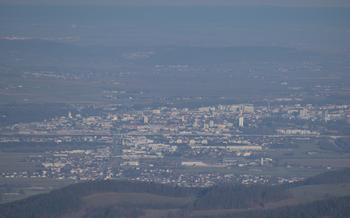
Benediktinerstift Göttweig
- History of Göttweig Abbey
- Location and Accessibility
- Architectural Highlights
- Guided Tours and Admission Fees
- Exhibits and Collections
- Monastery Grounds and Gardens
- Benedictine Community and Spirituality
- Pilgrimage and Religious Significance
- Cultural Events and Festivals
- Gastronomy and Hospitality
- Sustainability and Conservation
- Nearby Attractions and Day Trips:
- Photography and Social Media
- Accessibility for Visitors with Disabilities:
- Insider Tip: Unveiling Göttweig's Hidden Treasures
History of Göttweig Abbey
Deep within the heart of Austria, nestled atop a hill overlooking the serene Danube River, lies Göttweig Abbey, a Benedictine monastery that has stood as a testament to faith and cultural heritage for over 1,000 years. Founded in 1083 by Bishop Altmann of Passau, this sacred sanctuary has played a pivotal role in shaping the religious and cultural tapestry of the region. Over the centuries, Göttweig Abbey has undergone several architectural transformations, blending Romanesque, Gothic, and Baroque styles to create a masterpiece that harmoniously reflects the passage of time. Today, this architectural marvel stands as a living testament to the enduring spirit of faith and the power of human creativity.
Location and Accessibility
Benediktinerstift Göttweig is situated atop Göttweig Mountain, overlooking the picturesque town of Krems an der Donau in Lower Austria. Its exact address is Benediktinerstift 1, 3511 Göttweig. For further inquiries, you may reach the abbey by phone at +43 2732 85581-0 or via email at [email protected].
The abbey is conveniently located just an hour's drive from Vienna, Austria's capital city, making it an accessible day trip or weekend getaway. For those arriving by air, the nearest major airport is Vienna International Airport (VIE), which is approximately 75 kilometers away. From the airport, you can take a direct train to Krems an der Donau and then transfer to a local bus or taxi to reach Göttweig Abbey.
If you prefer public transportation, you can take a direct train from Vienna's central station (Wien Hauptbahnhof) to Krems an der Donau. From there, catch a bus or taxi to the abbey. The journey by train takes around 1 hour and 15 minutes, and the bus ride from Krems to Göttweig takes approximately 20 minutes.
Whether you choose to drive, take public transportation, or join a guided tour, visiting Benediktinerstift Göttweig is a rewarding and accessible experience, offering a glimpse into the rich history, stunning architecture, and spiritual significance of this Benedictine monastery.
Architectural Highlights
The architectural grandeur of Göttweig Abbey is a testament to its rich history and enduring legacy. The abbey's striking Baroque facade, designed by renowned architect Johann Lucas von Hildebrandt, features intricate carvings and sculptures that depict scenes from the Bible and the life of St. Benedict. The abbey church, the centerpiece of the complex, is adorned with breathtaking frescoes by Paul Troger, considered one of the masters of Baroque painting. These vibrant murals depict scenes from the Old and New Testaments and bring the stories of the Bible to life.
Inside the church, the high altar, a masterpiece of Baroque craftsmanship, commands attention with its elaborate carvings and gilding. The altar features a stunning altarpiece depicting the Assumption of the Virgin Mary, surrounded by statues of saints and angels. The church's stained glass windows, created by Tyrolean glassmakers, filter the sunlight, casting a kaleidoscope of colors onto the interior.
Beyond the church, the abbey boasts a series of courtyards, cloisters, and libraries, each with its own unique architectural charm. The arcaded courtyards, surrounded by elegant columns and arches, provide serene spaces for contemplation and reflection. The cloisters, with their vaulted ceilings and intricate tilework, offer a glimpse into the daily lives of the Benedictine monks. The abbey's library, a treasure trove of knowledge, houses a vast collection of medieval manuscripts, rare books, and historical documents.
Guided Tours and Admission Fees
To fully appreciate the history and significance of Göttweig Abbey, it is highly recommended to join a guided tour. Guided tours are available in German and English, and last approximately 5 hours. Visitors will be taken through the abbey's most important areas, including the abbey church, the cloisters, and the library. The knowledgeable guides will provide insights into the abbey's history, architecture, and religious significance.
Admission fees for the abbey vary depending on the type of ticket. A standard ticket for adults costs 12 euros, while reduced tickets for students and seniors are available for 9 euros. Family tickets and group discounts are also offered. It is advisable to book tickets in advance, especially during peak tourist season, to avoid long queues. Online booking is available on the abbey's website.
For those seeking a more in-depth experience, private guided tours can be arranged. Private tours offer greater flexibility and the opportunity to tailor the tour to specific interests. Visitors interested in photography or art may request a specialized tour focusing on the abbey's artistic treasures. Advance booking is required for private tours and can be arranged by contacting the abbey directly.
Exhibits and Collections
At the heart of Göttweig Abbey lies its captivating museum, a treasure trove of religious art and historical artifacts that narrate the abbey's rich past and spiritual legacy. Step inside to embark on a journey through time, where medieval manuscripts, intricate sculptures, and stunning paintings come alive.
Among the museum's highlights is its collection of medieval manuscripts, each a testament to the abbey's role as a center of learning and scholarship. Marvel at the delicate calligraphy and vibrant illuminations that adorn these ancient texts, offering a glimpse into the minds and hearts of medieval scribes.
The abbey's collection of sculptures is equally impressive, showcasing the artistry and devotion of talented craftsmen from centuries past. From delicate ivory carvings to imposing stone figures, these sculptures depict saints, angels, and biblical scenes, each imbued with its own unique character and symbolism.
Finally, the museum's collection of paintings spans various periods and styles, from medieval icons to Baroque masterpieces. Gaze upon the ethereal beauty of Madonnas and saints, or be captivated by the dramatic narratives depicted in large-scale canvases. These works of art not only adorn the abbey's walls but also provide a profound insight into the spiritual and artistic sensibilities of their time.
In addition to its permanent collection, the abbey also hosts temporary exhibitions, showcasing contemporary religious art and thought-provoking installations. These exhibitions provide a fresh perspective on the abbey's heritage and its ongoing relevance in the modern world.
Monastery Grounds and Gardens
Strolling through the extensive gardens surrounding BenediktinerStift Göttweig is a delight for all senses. Visitors are greeted by a tapestry of colors and aromas as they explore the meticulously manicured grounds. The herb garden, with its fragrant collection of culinary and medicinal plants, offers a glimpse into the abbey's rich history of herbal medicine.
A highlight of the gardens is the rose garden, boasting over 2,000 roses in a variety of colors and varieties. The sweet fragrance of the roses fills the air, creating an enchanting atmosphere. From the gardens, visitors can enjoy breathtaking panoramic views of the surrounding Wachau Valley, with its rolling hills, vineyards, and the majestic Danube River meandering through the landscape.
The gardens are open to the public during daylight hours, offering a tranquil oasis for relaxation and contemplation. Take your time to wander through the paths, admire the floral displays, and soak in the serene beauty of this natural sanctuary.
Benedictine Community and Spirituality
At the heart of Göttweig Abbey lies a vibrant community of Benedictine monks who have dedicated their lives to following the Rule of St. Benedict. This ancient set of principles emphasizes prayer, work, and community living. Visitors to the abbey can gain a glimpse into the daily lives of these monks, who rise before dawn for prayers and spend their days in a harmonious blend of work and spiritual contemplation.
The Benedictine Rule, written by St. Benedict in the 6th century, provides a framework for monastic life that balances individual contemplation with communal living. At Göttweig, the monks follow this rule diligently, adhering to a strict schedule of prayer, work, and study. They strive to create a welcoming and hospitable environment for visitors, offering guidance and spiritual support to those who seek it.
For those interested in deepening their spiritual understanding, Göttweig Abbey offers a variety of opportunities. Visitors can attend daily Mass, participate in guided meditations, or simply spend time in quiet reflection within the abbey's sacred spaces. The monks also offer spiritual retreats and workshops throughout the year, providing a unique opportunity for personal growth and transformation.
Pilgrimage and Religious Significance
Göttweig Abbey holds immense significance as a pilgrimage site, attracting both locals and visitors from afar. Its history as a spiritual center dates back centuries, and the abbey's reputation for sanctity and devotion has endured over time. Pilgrims are drawn to Göttweig to seek solace, guidance, and a deeper connection with their faith. The abbey's serene atmosphere and stunning architecture provide an ideal setting for contemplation and reflection.
Throughout history, Göttweig Abbey has played a pivotal role in the region's spiritual and religious development. It served as a center for the dissemination of Christianity, with Benedictine monks traveling throughout the region to spread the faith and establish new monasteries. The abbey's influence extended far beyond its walls, shaping the religious landscape and fostering a deep sense of community among believers.
The pilgrimage route to Göttweig Abbey is a well-established tradition, with pilgrims often choosing to walk or cycle the scenic route to the abbey. Along the way, they pass through picturesque villages, historic sites, and breathtaking natural landscapes, each offering its own unique charm. The journey itself becomes a pilgrimage of introspection and self-discovery, allowing pilgrims to connect with the region's rich cultural and spiritual heritage.
Cultural Events and Festivals
Göttweig Abbey is not just a place of prayer and contemplation; it's also a vibrant center for culture and the arts. Throughout the year, the abbey hosts a variety of events that celebrate music, art, and the rich history of the region.
One of the highlights of the abbey's cultural calendar is the Göttweig Music Festival, held annually in the summer months. This prestigious event brings together renowned musicians from around the world to perform in the abbey's stunning Baroque church. The festival features a diverse program of classical, contemporary, and sacred music, offering something for every taste.
In addition to the music festival, Göttweig Abbey also hosts regular concerts, exhibitions, and cultural events throughout the year. These events showcase the work of local and international artists, providing visitors with a unique opportunity to experience the creative spirit of the region.
To stay informed about upcoming events, check the abbey's website or follow their social media pages. Planning your visit around these events can enhance your experience and create lasting memories of your time at Göttweig Abbey.
Gastronomy and Hospitality
Göttweig Abbey offers a range of culinary delights for visitors to savor. The Klosterwirt Göttweig, situated within the abbey's historic walls, invites guests to indulge in traditional Austrian cuisine prepared with fresh, local ingredients. The menu features regional specialties such as Wiener Schnitzel, Tafelspitz, and Kaiserschmarrn. The Klostercafé is perfect for a lighter bite or a sweet treat, serving a selection of pastries, cakes, and coffees.
For those seeking a truly immersive experience, the abbey offers the opportunity to stay overnight at one of its guesthouses. The Gästehaus Göttweig and the Haus der Stille provide comfortable accommodations, allowing visitors to fully embrace the tranquility and spirituality of the abbey's surroundings. Advance reservations are recommended to secure a spot in these sought-after guesthouses.
Sustainability and Conservation
The Benedictine community at Göttweig Abbey is deeply committed to sustainability and environmental conservation. They recognize the importance of preserving the natural beauty and cultural heritage of the Wachau region, and actively implement various initiatives to reduce their ecological footprint.
The abbey utilizes renewable energy sources, such as solar panels and biomass heating, to meet its energy needs. They also practice organic farming methods in their extensive gardens, ensuring that the produce served at the abbey's restaurant is grown in an environmentally responsible manner.
Furthermore, the abbey plays a crucial role in preserving the region's cultural heritage. They maintain a vast collection of historical artifacts, manuscripts, and artwork, and actively participate in restoration projects to protect and preserve the abbey's architectural integrity.
By embracing sustainability and conservation, Göttweig Abbey serves as a model for other religious institutions and communities. Their efforts showcase how environmental responsibility can be seamlessly integrated into the spiritual and cultural life of a monastery.
Nearby Attractions and Day Trips:
Venturing beyond the walls of Göttweig Abbey, the surrounding region offers a wealth of attractions for travelers seeking further exploration. Within easy reach, picturesque towns and villages beckon with their unique charms. Stroll through the cobblestone streets of Krems an der Donau, renowned for its medieval architecture and vibrant cultural scene. Discover the enchanting town of Dürnstein, nestled amidst vineyards and crowned by a historic castle. History buffs can delve into the past at the nearby Melk Abbey, another architectural masterpiece and UNESCO World Heritage Site. Nature enthusiasts will find solace in the Wachau Valley, a stunning UNESCO-protected landscape with its rolling hills, lush forests, and sparkling Danube River. Plan a leisurely hike or bike ride along the Danube Cycle Path, taking in the breathtaking scenery and sampling local delicacies at charming villages along the way. Whether seeking cultural immersion, historical exploration, or natural wonders, the surroundings of Göttweig Abbey offer an array of experiences to enrich your Austrian adventure.
Photography and Social Media
The allure of Göttweig Abbey extends beyond its sacred walls, inspiring countless visitors to capture its grandeur through the lens of their cameras. To maximize your photography experience, consider these tips:
-
Golden Hour Magic: Plan your visit during sunrise or sunset to harness the warm, diffused light that casts an ethereal glow on the abbey's facade and surroundings.
-
Explore Hidden Corners: Venture beyond the main courtyards to discover hidden nooks and vantage points that offer unique perspectives for your shots.
-
Capture the Details: Zoom in on intricate architectural details, such as the delicate carvings on the high altar or the colorful frescoes adorning the ceilings.
-
Panoramic Views: Head to the abbey's gardens or the viewing terrace for breathtaking panoramic shots that encompass the abbey, the rolling countryside, and the distant Alps.
When sharing your photos on social media, remember to tag the abbey's official accounts (@gottweigabbey) and use relevant hashtags like #gottweigabbey, #austriatravel, and #baroquearchitecture. By sharing your experiences, you become part of a vibrant community of travelers and art enthusiasts who appreciate the beauty and history of this iconic landmark.
Accessibility for Visitors with Disabilities:
Göttweig Abbey is committed to ensuring that all visitors, including those with disabilities, can fully experience its architectural and spiritual wonders. The abbey grounds are largely wheelchair accessible, and ramps have been installed to facilitate movement between different levels. Visitors with disabilities can also request assistance from the abbey's staff, who are trained to provide support and guidance.
In addition, assistive devices such as wheelchairs and hearing aids are available upon request. For visitors who require sign language interpretation, the abbey can arrange for a qualified interpreter to accompany them on a guided tour. To ensure the best possible experience, visitors with disabilities are encouraged to contact the abbey in advance to discuss their specific needs and preferences. The abbey staff will be happy to assist in making necessary arrangements and providing any additional support required.
Insider Tip: Unveiling Göttweig's Hidden Treasures
For an unforgettable experience, venture beyond the main abbey complex and discover Göttweig's hidden gems. Explore the mystical "Göttweiger Bergfried", a medieval watchtower offering panoramic views of the Wachau Valley. Descend into the eerie, labyrinthine catacombs beneath the abbey, where mummified monks and historical artifacts await. Seek out the secluded "Prälatenbibliothek", a treasure trove of ancient manuscripts and rare books. With a bit of exploration, you'll uncover the hidden stories and secrets that make Göttweig Abbey truly extraordinary.
